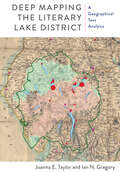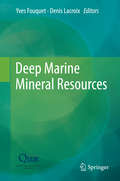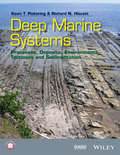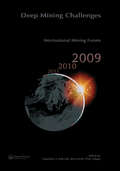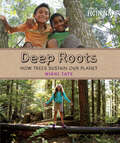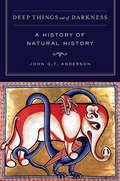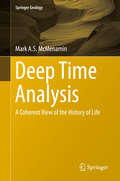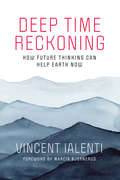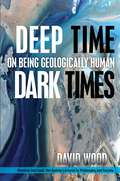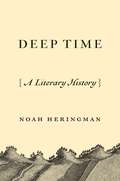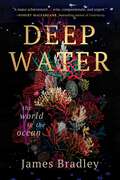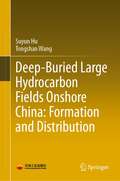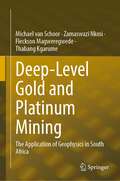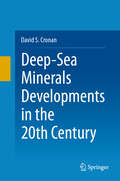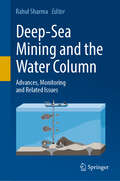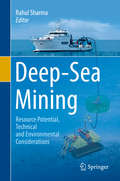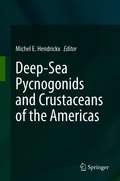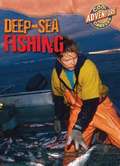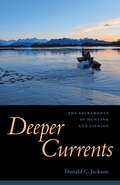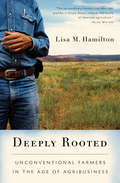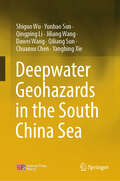- Table View
- List View
Deep Mapping the Literary Lake District: A Geographical Text Analysis (Aperçus: Histories Texts Cultures)
by Ian N. Gregory Joanna E. TaylorEngland’s famed Lake District—best known as the place of inspiration for the Wordsworths, Samuel Taylor Coleridge, and other Romantic-era writers—is the locus of this pioneering study, which implements and critiques a new approach to literary analysis in the digital age. Deploying innovative methods from literary studies, corpus linguistics, historical geography, and geographical information science, Deep Mapping the Literary Lake District combines close readings of a body of writing about the region from 1622-1900 with distant approaches to textual analysis. This path-breaking volume exemplifies interdisciplinarity, demonstrating how digital humanities methodologies and geospatial tools can enhance our appreciation of a region whose topography has been long recognized as fundamental to the shape of the poetry and prose produced within it.
Deep Marine Mineral Resources
by Yves Fouquet Denis LacroixThe risks of shortages for some crucial metals and uncertainty about the land-based reserves of several others justify the search to diversify our sources of supply and investigate their potential. Mineral resources in the deep sea are attracting increasing interest with the progressive discovery of various forms of ores. France possesses large areas of deep seafloor in the three oceans as well as world-class human and technological resources and know-how, resulting from over 40 years of experience. This study takes stock of knowledge about mineralisations and associated metals, technologies for exploring and exploiting them, biodiversity and the potential impact of exploitation on the deep environment and the partnerships which are vital for France and Europe. This information will be useful for decision-makers in drawing up strategies, defining research and development programmes and in enhancing and developing commercial utilizations for these high-potential resources.
Deep Marine Systems
by Kevin Pickering Richard HiscottDeep-water (below wave base) processes, although generally hidden from view, shape the sedimentary record of more than 65% of the Earth's surface, including large parts of ancient mountain belts. This book aims to inform advanced-level undergraduate and postgraduate students, and professional Earth scientists with interests in physical oceanography and hydrocarbon exploration and production, about many of the important physical aspects of deep-water (mainly deep-marine) systems. The authors consider transport and deposition in the deep sea, trace-fossil assemblages, and facies stacking patterns as an archive of the underlying controls on deposit architecture (e.g., seismicity, climate change, autocyclicity). Topics include modern and ancient deep-water sedimentary environments, tectonic settings, and how basinal and extra-basinal processes generate the typical characteristics of basin slopes, submarine canyons, contourite mounds and drifts, submarine fans, basin floors and abyssal plains.
Deep Mining Challenges: International Mining Forum 2009
by Volodymyr I. BondarenkoThe International Mining Forum is an annual meeting of scientists and professionals specializing in a broad area of mining sciences. The aim of the meeting is to exchange new ideas and experiences, evaluate previously implemented solutions and procedures and to discuss new ideas that might change the procedures, developments and the image of the mining industry as a whole.The topics covered in the proceedings of IMF 2009 are:- Mineral resources / reserves evaluation,- Classification of Fossil Energy and Mineral Resources,- Directions and Developments of Present-Day Mining.
Deep Oakland: How Geology Shaped a City
by Andrew AldenA San Francisco Chronicle BestsellerRead the rocks as only a geologist can, with this deep drill-down into Oakland’s geological history and its impacts on the city’s urban present."This book has turned me into a newcomer to my own city, but has also changed the way I will view any landscape. I can think of few greater gifts than that."—Jenny Odell, author of How to Do Nothing"Spending time with Andrew Alden is like giving yourself x-ray eyes." —Roman Mars, host and creator of 99% InvisibleBeneath Oakland’s streets and underfoot of every scurrying creature atop them, rocks roil, shift, crash, and collide in an ever-churning seismological saga. Playing out since time immemorial, the deep geology of this city has chiseled and carved its landforms and the lives of everyone—from the Ohlone to the settlers to the transients and transplants—who has called this singular place home.In Deep Oakland, geologist Andrew Alden excavates the ancient story of Oakland’s geologic underbelly and reveals how its silt, soil, and subterranean sinews are intimately entwined with its human history—and future. Poised atop a world-famous fault line now slumbering, Alden charts how these quaking rocks gave rise to the hills and the flats; how ice-age sand dunes gave root to the city’s eponymous oak forests; how the Jurassic volcanoes of Leona Heights gave way to mining boom times; how Lake Merritt has swelled and disappeared a dozen times over the course of its million-year lifespan; and how each epochal shift has created the terrain cradling Oaklanders today. With Alden as our guide—and with illustrations by Laura Cunningham, author of A State of Change—we see that just as Oakland is a human crossroads, a convergence of cultures from the world over, so too is the bedrock below, carried here from parts still incompletely known.
Deep Roots: How Trees Sustain Our Planet (Orca Footprints #8)
by Nikki TateMost of us see trees every day, and too often we take them for granted. Trees provide us with everything from food, fuel and shelter to oxygen and filtered water. Deep Roots celebrates the central role trees play in our lives, no matter where we live. Each chapter in Deep Roots focuses on a basic element—water, air, fire and earth—and explores the many ways in which we need trees to keep our planet healthy and livable. From making rain to producing fruit to feeding fish, trees play an integral role in maintaining vibrant ecosystems all over the world. Facts about trees and hands-on activities throughout help readers discover ways to get to know our giant neighbors better.
Deep Sea: 10 Things You Should Know
by Jon CopleyUncover what lies at the deepest depths of our oceans...In ten brief and informative essays, marine biologist and TV science advisor Professor Jon Copley journeys to one of the most mysterious and fascinating environments on Earth, the deep sea. Discover what makes this unique habitat such a challenging environment, the creatures that call it home and how ocean explorers are able to utilise the latest technology to aid their research and travel miles below the ocean surface.The Deep Sea: 10 things you should know is a brilliant guide to one of the most fascinating and curious places known to humankind.
Deep Things out of Darkness
by John G. AndersonNatural history, the deliberate observation of the environment, is arguably the oldest science. From purely practical beginnings as a way of finding food and shelter, natural history evolved into the holistic, systematic study of plants, animals, and the landscape. Deep Things out of Darkness chronicles the rise, decline, and ultimate revival of natural history within the realms of science and public discourse. Ecologist John G. T. Anderson focuses his account on the lives and contributions of an eclectic group of men and women, from John Ray, John Muir, Charles Darwin, and Rachel Carson, who endured remarkable hardships and privations in order to learn more about their surroundings. Written in an engaging narrative style and with an extensive bibliography of primary sources, the book charts the journey of the naturalist's endeavor from prehistory to the present, underscoring the need for natural history in an era of dynamic environmental change.
Deep Time Analysis: A Coherent View Of The History Of Life (Springer Geology)
by Mark A.S. McMenaminUsing a series of case studies, the book demonstrates the power of dynamic analysis as applied to the fossil record. The book considers how we think about certain types of paleontological questions and shows how to answer them. The analytical tools presented here will have wide application to other fields of knowledge; as such the book represents a major contribution to the deployment of modern scientific method as it builds on author's previous book, Dynamic Paleontology. Students and seasoned professionals alike will find this book to be of great utility for refining their approach to their ongoing and future research projects.
Deep Time Reckoning: How Future Thinking Can Help Earth Now (One Planet)
by Vincent IalentiA guide to long-term thinking: how to envision the far future of Earth.We live on a planet careening toward environmental collapse that will be largely brought about by our own actions. And yet we struggle to grasp the scale of the crisis, barely able to imagine the effects of climate change just ten years from now, let alone the multi-millennial timescales of Earth's past and future life span. In this book, Vincent Ialenti offers a guide for envisioning the planet's far future--to become, as he terms it, more skilled deep time reckoners. The challenge, he says, is to learn to inhabit a longer now.
Deep Time, Dark Times: On Being Geologically Human (Thinking Out Loud)
by David WoodThe new geological epoch we call the Anthropocene is not just a scientific classification. It marks a radical transformation in the background conditions of life on Earth, one taken for granted by much of who we are and what we hope for. Never before has a species possessed both a geological-scale grasp of the history of the Earth and a sober understanding of its own likely fate. Our situation forces us to confront questions both philosophical and of real practical urgency. We need to rethink who “we” are, what agency means today, how to deal with the passions stirred by our circumstances, whether our manner of dwelling on Earth is open to change, and, ultimately, “What is to be done?” Our future, that of our species, and of all the fellow travelers on the planet depend on it.The real-world consequences of climate change bring new significance to some very traditional philosophical questions about reason, agency, responsibility, community, and man’s place in nature. The focus is shifting from imagining and promoting the “good life” to the survival of the species. Deep Time, Dark Times challenges us to reimagine ourselves as a species, taking on a geological consciousness. Drawing promiscuously on the work of Nietzsche, Heidegger, Foucault, Derrida, Deleuze, and other contemporary French thinkers, as well as the science of climate change, David Wood reflects on the historical series of displacements and de-centerings of both the privilege of the Earth, and of the human, from Copernicus through Darwin and Freud to the declaration of the age of the Anthropocene. He argues for the need to develop a new temporal phronesis and to radically rethink who “we” are in respect to solidarity with other humans, and responsibility for the nonhuman stakeholders with which we share the planet. In these brief, lively chapters, Wood poses a range of questions centered on our individual and collective political agency. Might not human exceptionalism be reborn as a sort of hyperbolic responsibility rather than privilege?
Deep Time: A Literary History
by Noah HeringmanHow the concept of “deep time” began as a metaphor used by philosophers, poets, and naturalists in the eighteenth and nineteenth centuriesIn this interdisciplinary book, Noah Heringman argues that the concept of “deep time”—most often associated with geological epochs—began as a metaphorical language used by philosophers, poets, and naturalists of the eighteenth and nineteenth centuries to explore the origins of life beyond the written record. Their ideas about “the abyss of time” created a way to think about the prehistoric before it was possible to assign dates to the fossil record. Heringman, examining stories about the deep past by visionary thinkers ranging from William Blake to Charles Darwin, challenges the conventional wisdom that the idea of deep time came forth fully formed from the modern science of geology. Instead, he argues, it has a rich imaginative history.Heringman considers Johann Reinhold Forster and Georg Forster, naturalists on James Cook’s second voyage around the world, who, inspired by encounters with Pacific islanders, connected the scale of geological time to human origins and cultural evolution; Georges-Louis Leclerc, Comte de Buffon, who drew on travel narrative, antiquarian works, and his own fieldwork to lay out the first modern geological timescale; Blake and Johann Gottfried Herder, who used the language of fossils and artifacts to promote ancient ballads and “prehistoric song”; and Darwin’s exploration of the reciprocal effects of geological and human time. Deep time, Heringman shows, has figural and imaginative dimensions beyond its geological meaning.
Deep Water: The World in the Ocean
by James Bradley"Deep Water is a major achievement....Bradley's skills both as novelist and essayist converge here to create this wise, compassionate and urgent book, characterized throughout by a clarity of prose and a bracing moral gaze that searches water, self and reader." —ROBERT MACFARLANE, bestselling author of UnderlandIn this thrilling work—a blend of history, science, nature writing, and environmentalism—acclaimed writer James Bradley plunges into the unknown to explore the deepest recesses of the natural world.Seventy-one percent of the earth’s surface is ocean. These waters created, shaped, and continue to sustain not just human life, but all life on Planet Earth, and perhaps beyond it. They serve as the stage for our cultural history—driving human development from evolution through exploration, colonialism, and the modern era of global leisure and trade. They are also the harbingers of the future—much of life on Earth cannot survive if sea levels are too low or too high, temperatures too cold or too warm. Our oceans are vast spaces of immense wonder and beauty, and our relationship to them is innate and awe inspired.Deep Water is both a lyrically written personal meditation and an intriguing wide-ranging reported epic that reckons with our complex connection to the seas. It is a story shaped by tidal movements and deep currents, lit by the insights of philosophers, scientists, artists and other great minds. Bradley takes readers from the atomic creation of the oceans, to the wonders within, such as fish migrations guided by electromagnetic sensing. He describes the impacts of human population shifts by boat and speaks directly and uncompromisingly to the environmental catastrophe that is already impacting our lives. It is also a celebration of the ocean’s glories and the extraordinary efforts of the scientists and researchers who are unlocking its secrets. These myriad strands are woven together into a tapestry of life that captures not only our relationship with the planet, but our past, and perhaps most importantly, what lies ahead for us.A brilliant blend of Robert MacFarlane’s Underland, Susan Casey’s The Underworld, and Simon Winchester’s Pacific and The Atlantic, Deep Water taps into the essence of our planet and who we are.
Deep-Buried Large Hydrocarbon Fields Onshore China: Formation and Distribution
by Suyun Hu Tongshan WangThis book analyzes the formation and evolution of the giant hydrocarbon reservoirs based on major basins onshore China. It discusses exploration and research advantages of major basins in China, such as Sichuan, Tarim, and Ordos Basins and also systematically analyzes and summarizes the formation conditions, distribution rules, and main controlling factors of deep oil and gas fields. On this basis, it forecasts the exploration prospect of China's onshore deep oil and gas, providing theoretical guidance and technical support for deep oil and gas exploration breakthrough and large-scale reserves growth. This book focuses on the analysis and discussion of hydrocarbon generation mechanism of deep-paleo source rocks, discusses the accumulation rules of cross-structural reservoir formation and oil-gas enrichment in ancient strata, the combination of gypsum-salt rocks and carbonate rocks, the potential of oil and gas accumulation under salt, the main controlling factors and distribution rules of deep oil and gas fields, and preliminarily grasps the geological understanding of the formation and distribution of deep-large oil and gas fields, namely ①abundant hydrocarbon supplied by two types of source kitchens, ②three large-scale lithologic reservoir rocks, ③hydrocarbon accumulation controlled by three paleoes (paleouplift, paleoplatform margin, and paleofaults), and ④reservoir formation across major tectonic periods. The book serves as a guidance for both researchers and students majoring in petroleum geology and other related fields.
Deep-Level Gold and Platinum Mining: The Application of Geophysics in South Africa
by Michael van Schoor Zamaswazi Nkosi Fleckson Magweregwede Thabang KgarumeThis book provides the basic know-how and guidance to effectively exploit non-destructive geophysical technologies and apply them in the underground mining environment to optimise mineral extraction and to contribute to safer mining. The effective application of these technologies can enable a better understanding of the unseen orebody and the surrounding rock mass ahead of the mining face; the potential benefits of applying in-mine geophysics is demonstrated through a selection of case studies conducted in deep-level hard rock mines in South Africa. This book also offers valuable insight and training material for students in a variety of relevant mining disciplines like geology, rock engineering, mining engineering, mine planning and mineral resource management.
Deep-Sea Minerals Developments in the 20th Century
by David S. CronanThe book is an historical monograph on deep-sea mineral-related activities and attitudes towards deep-sea mining in the 20th Century which makes comparisons with the current situation in regard to those activities and attitudes. It reviews developments in the study of, and prospects and plans for mining deep-sea manganese nodules, cobalt-rich crusts, hydrothermal deposits, and phosphorites, and discusses associated environmental, technological, and economic issues. It is based on several sources. First, the author’s experience gleaned from around 50 years of attending conferences on the subject (the most important of which was the annual Underwater Mining Institutes held from 1970 onwards at which much of the material in the book was first exposed), second, discussions with and advice from the author's colleagues on the subject, all attributed, and third, the published literature. The target audiences are marine mining companies and their associates, marine environmentalists, UN and Government administrators responsible for seabed activities, undergraduate students of marine affairs and history, and interested lay persons. Unique features include the widespread sources used including unpublished conference proceedings and reports, personal insights gleaned from more than 50 years of working in the field, the author’s publications dating from 1967-2022, and attributed personal communications from the author’s colleagues.
Deep-Sea Mining and the Water Column: Advances, Monitoring and Related Issues
by Rahul SharmaThis book focuses on general issues of deep-sea mining for seafloor mineral deposits, as well as the scientific, technical, legal and policy issues related to impacts on the water column. The topic is a growing area of significance due to the ongoing conversations on this issue in the world community, in view of the large-scale consequences resulting from operations of different components of deep-sea mining systems. The chapters are divided in five sections, and are contributed by highly acclaimed scientists, technologists, lawyers and administrators who have decades of experience working on these topics. The information compiled in the book is expected to serve as an important reference for all stakeholders including researchers, contractors, mining companies, regulators and NGOs involved in deep-sea mining and marine environmental conservation. Section 1 provides an overall view of the current status of deep-sea mining and issues related to the water column. Section 2 looks at the engineering considerations for technology related to mining, handling of bulk solids in the marine environment, transporting the ores from seabed to shore as well as processing of deep-sea minerals. Section 3 discusses various approaches for assessment of impacts of deep-sea mining on the water column. Section 4 assesses the chemical, physical and biological characteristics of the water column in different oceans of the world. Finally, section 5 deals with legal, policy and economic aspects of deep-sea mining.
Deep-Sea Mining: Resource Potential, Technical and Environmental Considerations
by Rahul SharmaThis comprehensive book contains contributions from specialists who provide a complete status update along with outstanding issues encompassing different topics related to deep-sea mining. Interest in exploration and exploitation of deep-sea minerals is seeing a revival due to diminishing grades and increasing costs of processing of terrestrial minerals as well as availability of several strategic metals in seabed mineral resources; it therefore becomes imperative to take stock of various issues related to deep-sea mining. The authors are experienced scientists and engineers from around the globe developing advanced technologies for mining and metallurgical extraction as well as performing deep sea exploration for several decades. They invite readers to learn about the resource potential of different deep-sea minerals, design considerations and development of mining systems, and the potential environmental impacts of mining in international waters.
Deep-Sea Pycnogonids and Crustaceans of the Americas
by Michel E. HendrickxAmong the deep-sea marine invertebrates, pycnogonids and crustaceans represent ecologically important and most diverse groups of species. Yet both are still poorly understood. Sampling and exploring operations off the west and east coast of the Americas has significantly increased in the last two decades. However such operations are very costly and limited in number and frequency. In countries like Brazil, Canada, Chile, Colombia, Costa Rica, Mexico, Peru, the United States of America, and El Salvador a large effort has been made to explore the deep-sea resources and the rich diversity of the communities, resulting in a better understanding of the natural ecosystems on both coasts of America. Pycnogonids and many groups of deep-sea crustaceans have been intensively studied, from the smallest animals, like the mostly unknown benthic copepods to the largest decapods.This book presents new and updated information on various groups of deep-sea pycnogonids and crustaceans occurring off the American continent. Offering a valuable reference resource for scientists interested in this fascinating fauna, it includes review papers and new data on the deep-sea communities occurring off the USA, Mexico, El Salvador, Costa Rica, Colombia, Chile, Peru, Brazil and Argentina, as well as in larger areas in both the East Pacific and the West Atlantic. As such it covers most of the current deep-water research in Latin America.
Deep-sea Explorer: The Story of Robert Ballard, Discoverer of the Titanic
by Rick ArchboldThe story of how Robert Ballard discovered and explored the Titanic shipwreck.
Deep-sea Fishing (Cool Adventure Careers)
by William David ThomasThe first group of titles in an ongoing series introduces students to six amazing adventure careers. Geared for reluctant readers in upper elementary school and above, each high-interest title combines easy-to-follow text with engaging on-the-job photos to spark students' interest in reading and career exploration. Each book is filled with descriptive information about the career, along with the skills and requirements needed to pursue a job in the profiled field.
Deeper Currents: The Sacraments of Hunting and Fishing
by Donald C. JacksonIn Deeper Currents, Donald C. Jackson guides us on a journey into the cathedrals of wild and lonely places, those sacred spaces where hunters and fishers connect with the rhythms of the earth and the spirit that resonates within us. Jackson explores hunting and fishing as frameworks—sacraments—for discovering, engaging, and finding meaning. He invites readers to consider connections with wilder realms of being. Hunting squirrels on an autumn morning, probing the woods, rifle in hand, Jackson reveals an attention to nature too often neglected. Following a bird dog into the damp and mysterious places where woodcock settle on their southbound migrations; chasing hounds on the trail of raccoons on a frosty winter night; stalking deer in a quiet corner of a small farm; fishing for carp in a creek, bass and bluegill in ponds, catfish in a murky river, and reef fish in the Gulf, Jackson reminds that we are stewards of not only resources but also a past that defines us as hunters and fishers. We must pass this legacy along to the generations that follow. In Deeper Currents, tractors and old barns find a place in the reader's heart. Boats and canoes navigate realms of danger and dreams. Jackson shares outdoor pilgrimages with good friends in cabins, tents, camps, and old trailers tucked beyond the reach of a rushing world. He rejoices in the whisper of stiff wings as ducks come to decoys, the call of geese and cranes over tidal flats, the hush before a storm, the muffled snap of a twig at twilight, a drop of dew falling on the surface of a pond, and the clicking of caribou hooves on an Alaskan gravel bar. Jackson finds these natural moments fill us with energy. They remind us that we are taking part in a sacred heritage and that creation is unfolding all around us.
Deeply Rooted: Unconventional Farmers in the Age of Agribusiness
by Lisa M. HamiltonA century of industrialization has left our food system riddled with problems, yet for solutions we look to nutritionists and government agencies, scientists and chefs. Lisa M. Hamilton asks: Why not look to the people who grow our food?Hamilton makes this vital inquiry through the stories of three unconventional farmers: an African-American dairyman in Texas who plays David to the Goliath of agribusiness corporations; a tenth-generation rancher in New Mexico struggling to restore agriculture as a pillar of his crumbling community; and a modern pioneer family in North Dakota who is breeding new varieties of plants to face the future's double threat: Monsanto and global warming. Threads of history and discussion weave through the tales, exploring how farmers have been pushed to the margins of agriculture and transformed from leaders to laborers.These unusual characters and their surprising stories make the case that in order to correct what has gone wrong with the food system, we must first bring farmers back to the table.
Deepwater Alchemy: Extractive Mediation and the Taming of the Seafloor
by Lisa Yin HanHow underwater mediation has transformed deep-sea spaces into resource-rich frontiers Green energy technologies such as windmills, solar panels, and electric vehicles may soon depend on material found at the seabed. How did a space once imagined to be empty and unfathomable come to be thought of as a treasure trove of resources? Lisa Yin Han traces how contemporary developments in underwater sensing and imaging materially and imaginatively transmogrify the ocean bottom into a resource frontier capable of sustaining a digitally connected global future. Set against the backdrop of climate change, energy transition, and the expansion of industrial offshore extractions, Deepwater Alchemy looks at oceanic media and its representation of the seabed in terms of valuable resources. From high-tech simulations to laboratories and archives that collect and analyze sediments, Han explores the media technologies that survey, visualize, and condition the possibility for industrial resource extraction, introducing the concept of extractive mediation to describe the conflations between resource prospecting and undersea knowledge production. Moving away from anthropocentric frameworks, she argues that we must equalize access to deep ocean mediation and include the submerged perspectives of multispecies communities. From the proliferation of petroleum seismology to environmental-impact research on seabed mining to the development of internet-enabled seafloor observatories, Deepwater Alchemy shows us that deepwater mediation is entangled in existential hopes and fears for our planetary future. As the ocean bottom becomes increasingly accessible to people, Han prompts us to ask not whether we can tame the seafloor, but, rather, why and for whom are we taming it?
Deepwater Geohazards in the South China Sea
by Shiguo Wu Yunbao Sun Qingping Li Jiliang Wang Dawei Wang Qiliang Sun Chuanxu Chen Yangbing XieThis book comprehensively analyzes and summarizes the types, characteristics and prevention of deep-sea geological disasters in the South China Sea based on the research progress of global background. It also brings attention to the general public and stakeholders the risks of deep-sea geological disasters.
